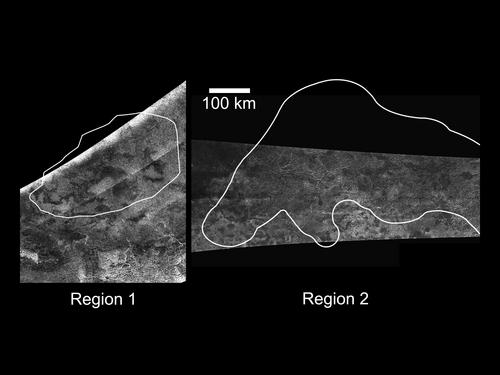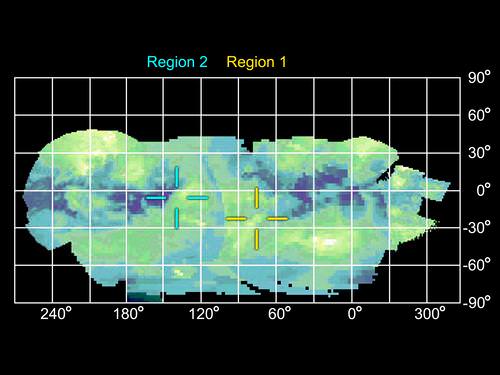[/caption]
A cold volcano seems like an oxymoron, but active “cryovolcanoes” may actually be spewing a super-chilled liquid into the atmosphere of Saturn’s moon Titan. The beauty of Cassini’s long and now extended mission is the numerous flybys the spacecraft is able to take of several of Saturn’s most interesting moons. We reported yesterday how scientists have been able to see how Enceladus’ surface and its geysers are changing over time, and now data collected during several recent flybys of Titan show alternations in that moon’s surface as well. “Cassini data have raised the possibility that Titan’s surface is active,” said Jonathan Lunine, a Cassini interdisciplinary scientist from the Lunar and Planetary Laboratory, at the University of Arizona, Tucson . “This is based on evidence that changes have occurred on the surface of Titan, between flybys of Cassini, in regions where radar images suggest a kind of volcanism has taken place.”
Rather than erupting hot, molten rock, it is theorized that the cryovolcanoes of Titan would erupt volatiles such as water, ammonia and methane. Scientists have suspected cryovolcanoes might populate Titan, and the Cassini mission has collected data on several previous passes of the moon that suggest their existence. Imagery of the moon has included a suspect haze hovering over flow-like surface formations. Scientists point to these as signs of cryovolcanism there.
What led some Cassini scientists to believe that things are happening now were changes in brightness and reflectance detected at two separate and distinct regions of Titan. Reflectance is the ratio of light that radiates onto a surface to the amount reflected back. These changes were documented by Visible and Infrared Mapping Spectrometer data collected on Titan flybys from July 2004 to March 2006. In one of the two regions, the reflectance of the surface surged upward and remained higher than expected. In the other region, the reflectance shot up but then trended downward. There is also evidence that ammonia frost is present at one of the two changing sites. The ammonia was evident only at times when the region was inferred to be active. Watch a video of the changes.
“Ammonia is widely believed to be present only beneath the surface of Titan,” said Robert M. Nelson of JPL, a scientist for Cassini’s Visual and Infrared Mapping Spectrometer team. “The fact that we found it appearing at times when the surface brightened strongly suggests that material was being transported from Titan’s interior to its surface.”

Some Cassini scientists indicate that such volcanism could release methane from Titan’s interior, which explains Titan’s seemingly continuous supply of fresh methane. Without replenishment, scientists say, Titan’s original atmospheric methane should have been exhausted long ago.
But other scientists aren’t certain that cryovolcanoes are responsible for the changes seen on Titan. Instead the changes might result from the transient appearances of ground “fogs” of ethane droplets very near Titan’s surface, driven by atmospheric rather than geophysical processes. Nelson has considered the ground fog option, stating, “There remains the possibility that the effect is caused by a local fog, but if so, we would expect it to change in size over time due to wind activity, which is not what we see.”
An alternative hypothesis to an active Titan suggests the Saturnian moon could be taking its landform evolution cues from a moon of Jupiter.
“Like Callisto, Titan may have formed as a relatively cold body, and may have never undergone enough tidal heating for volcanism to occur,” said Jeffrey Moore, a planetary geologist at the NASA Ames Research Center, Moffett Field, Calif. “The flow-like features we see on the surface may just be icy debris that has been lubricated by methane rain and transported downslope into sinuous piles like mudflows.”
But scientists will continue to analyze and collect more data in attempt to pinpoint exactly what is happening on Titan. Cassini’s next Titan flyby is scheduled for Dec. 21, when the spacecraft will come within 970 kilometers (603 miles) of its cloud-shrouded surface.
Source: JPL


I’m confused. I thought the hydrocarbon cryovolcanoes with alkanes up to octane were discovered in June 2005?
http://www.jpl.nasa.gov/news/news.cfm?release=2005-096
http://www.nasa.gov/mission_pages/cassini/multimedia/pia07965.html
“Some Cassini scientists indicate that such volcanism could release methane from Titan’s interior, which explains Titan’s seemingly continuous supply of fresh methane. Without replenishment, scientists say, Titan’s original atmospheric methane should have been exhausted long ago.”
Got to love infinite oil.
I’d bet big money that there’s life somewhere in the Saturn system.
@Fst
Darn right. Can’t understand all this fascination with Mars myself.
@NoAstronomer:
The main reason of the fascination with Mars is that it’s much easier and cheaper to send probes and landers there.
I would love to see a returned sample from Enceladus’ oceans or from Titan’s lakes in my life. I’m 22, so there’s a chance 🙂
I’ll take your money, Fst. It staggers me how blithely people in general assume that where life CAN exist, it MUST exist. This completely ignores the difficulty of getting it started in the first place. Only now are the likes of Craig Venter even beginning to approach getting a functional cell going from scratch, and that’s with the best of intentions. This is still a million miles away from understanding how it gets going ‘in the wild’. Yes, I know 4600 million years is a long time, but 4600 million times zero is still zero.
MY money is on life turning out to be extremely rare beyond Earth, and that this above all else is the reason for Fermi’s paradox.
the video link might be broken. I get an error message.
cryovolcanoes are SICK
@Jenifer (and Nancy)
The link should probably be http://saturn.jpl.nasa.gov/video/videodetails/?videoID=182 but the site itself seems to have some technical problem.